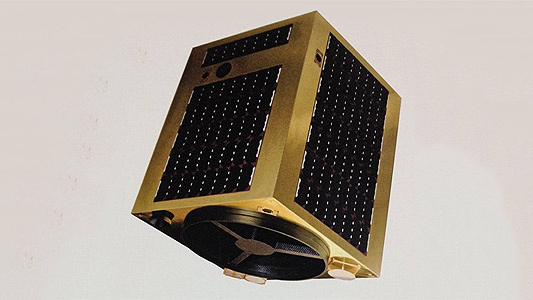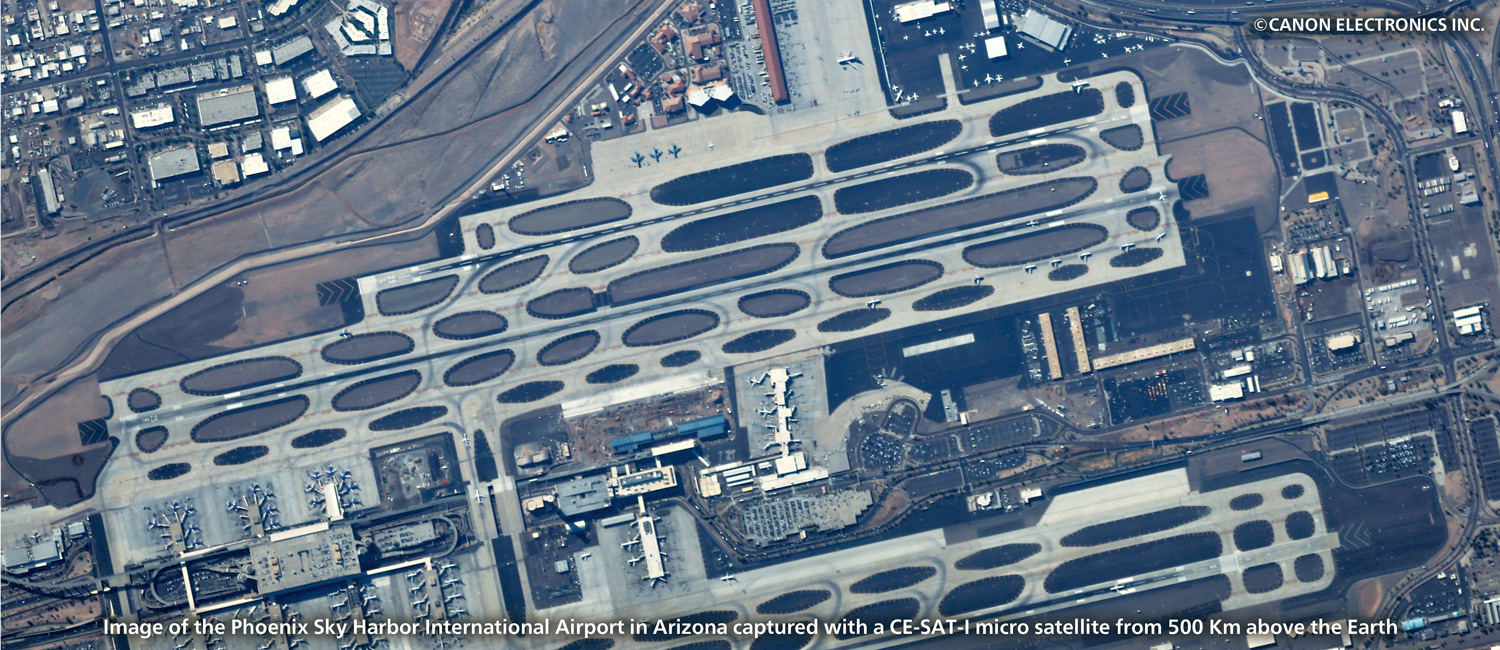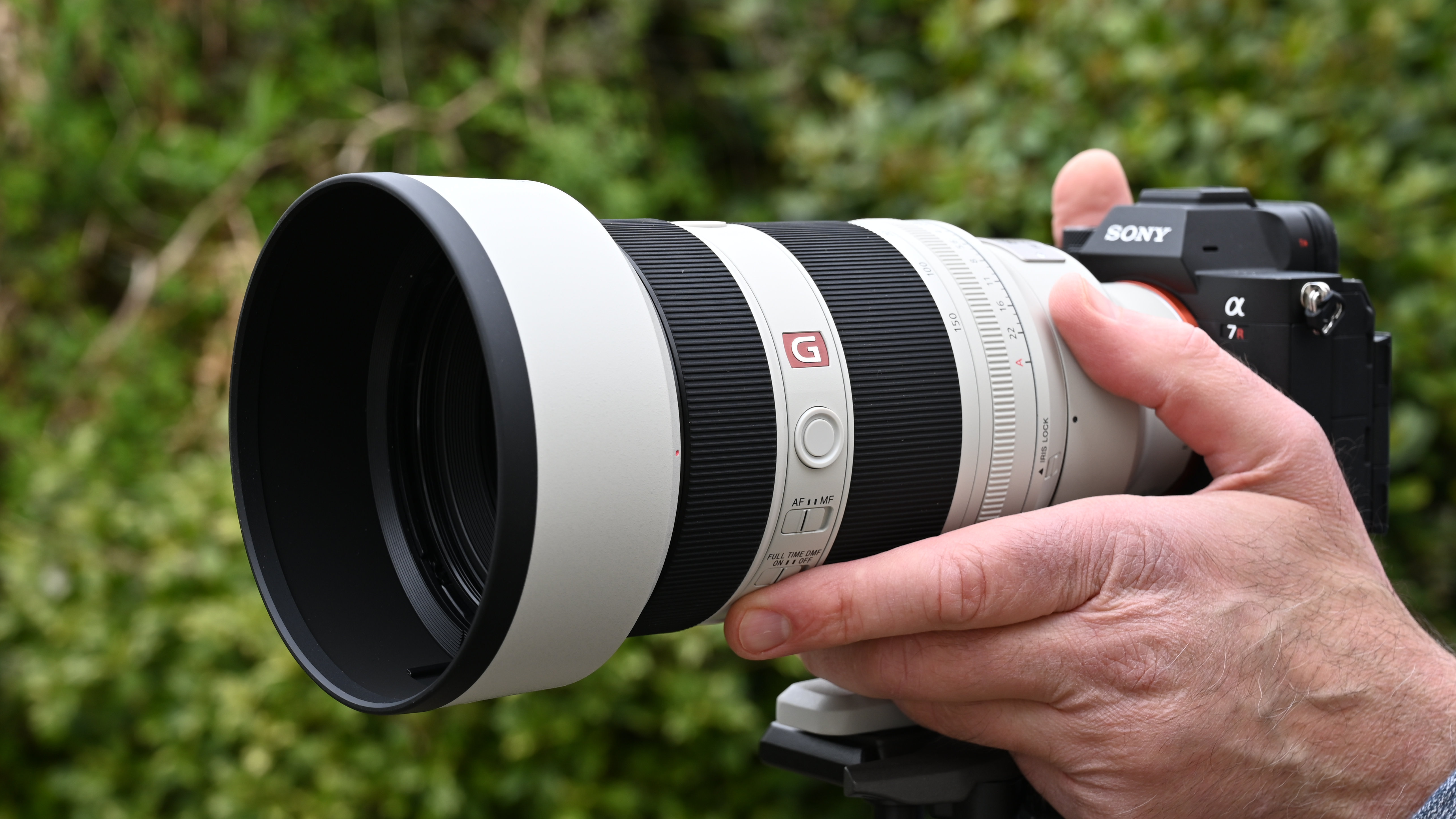Canon spacecraft crashes on take-off
Canon CE-SAT 1B had a 5D Mark III, PowerShot and a 3,720mm lens onboard - but launch rocket failed minutes after take-off

UPDATE: Sad news this weekend as Canon's plans to go into space are back on the drawing board. The Rocket Lab rocket taking its CE-SAT 1B satellite into orbit failed to make it into orbit, after a problem developed during the second burn phase of the launch. Read the full story of the launch failure and the loss of the Canon spacecraft at Space.com.
"Today's anomaly occurred after 11 consecutive successful orbital launches of the Electron launch vehicle", commented the launch team. "Rocket Lab currently has more than eight Electron vehicles in production, ready for a rapid return to flight as soon as investigations are complete and any required corrective actions are in place".

ORIGINAL STORY: Canon is once again taking astrophotography to the next level, with the imminent launch of its CE-SAT 1B spacecraft in July.
However, while astrophotography usually involves taking photographs of the stars, Canon will be turning the genre on its head by pointing a camera towards Earth – one that's capable of resolving a 90cm object on the ground, from space!
So what kind of camera tech is inside such a remarkable imaging satellite – the cutting-edge Canon EOS R5? The company's dedicated full-frame mirrorless astrophotography camera, the Canon EOS Ra?
Actually, no. The primary camera detector inside the CE-SAT 1B ("Canon Electric Satellite") is none other than the Canon EOS 5D Mark III – which may be old, but is one of the best Canon cameras ever made.
• Best cameras for astrophotography
Get the Digital Camera World Newsletter
The best camera deals, reviews, product advice, and unmissable photography news, direct to your inbox!
As surprising as the main camera may be, its secondary detector is even more surprising: a Canon PowerShot S110, which is being used as the satellite's wide-angle camera system.
The main telephoto camera, though, is the 5D Mark III. And, according to Gunther's Space Page, it has been outfitted with a 40 cm diameter Cassegrain telescope with 3720 mm focal length, which "provides an 1m ground resolution from a 600 km orbit with a 6 km × 4 km frame size."

So what of the launch itself? The Canon CE-SAT 1B will rideshare with Rocket Lab’s Electron, which will lift off from Rocket Lab's Launch Complex 1, located on Mahia Peninsula on New Zealand's North Island. The launch window opens on 04 July New Zealand time. The mission, brilliantly, is called Pics Or It Didn't Happen.
“We’re looking forward to getting these next generation Canon spacecraft on orbit and helping them kickstart their constellation,” said Curt Blake, CEO of Spaceflight – the organization that organizes these satellite rideshares. “Our ability to find the most expedient rides to space for our customers is critical, especially when their business plans require a frequent cadence of launches.”
The next in this cadence is set to take place later this year, featuring the more advanced CE-SAT-11B that features three cameras.
“This launch is very critical for Canon Electronics as we are launching a satellite where we have remarkably increased the ratio of in-house development of components compared to the previous launch,” added Dr Nobutada Sako, group executive, Satellite Systems Lab, Canon Electronics Inc.
The previous launch saw the original CE-SAT 1 lift off from India in 2017. According to Canon, the CE-SAT-IB due for launch in July "will go through a 2 year demonstration experiment for forthcoming mass production."
Read more:
Canon EOS Ra review
The best CCD cameras for astrophotography
The best lenses for astrophotography: fast ultra-wide lenses for the night sky
UPDATE: Sad news this weekend as Canon's plans to go into space are back on the drawing board. The Rocket Lab rocket taking its CE-SAT 1B satellite into orbit failed to make it into orbit, after a problem developed during the second burn phase of the launch. Read the full story of the launch failure and the loss of the Canon spacecraft.
"Today's anomaly occurred after 11 consecutive successful orbital launches of the Electron launch vehicle", commented the launch team. "Rocket Lab currently has more than eight Electron vehicles in production, ready for a rapid return to flight as soon as investigations are complete and any required corrective actions are in place".

ORIGINAL STORY: Canon is once again taking astrophotography to the next level, with the imminent launch of its CE-SAT 1B spacecraft in July.
However, while astrophotography usually involves taking photographs of the stars, Canon will be turning the genre on its head by pointing a camera towards Earth – one that's capable of resolving a 90cm object on the ground, from space!
So what kind of camera tech is inside such a remarkable imaging satellite – the cutting-edge Canon EOS R5? The company's dedicated full-frame mirrorless astrophotography camera, the Canon EOS Ra?
Actually, no. The primary camera detector inside the CE-SAT 1B ("Canon Electric Satellite") is none other than the Canon EOS 5D Mark III – which may be old, but is one of the best Canon cameras ever made.
• Best cameras for astrophotography
As surprising as the main camera may be, its secondary detector is even more surprising: a Canon PowerShot S110, which is being used as the satellite's wide-angle camera system.
The main telephoto camera, though, is the 5D Mark III. And, according to Gunther's Space Page, it has been outfitted with a 40 cm diameter Cassegrain telescope with 3720 mm focal length, which "provides an 1m ground resolution from a 600 km orbit with a 6 km × 4 km frame size."
UPDATE: Sad news this weekend as Canon's plans to go into space are back on the drawing board. The Rocket Lab rocket taking its CE-SAT 1B satellite into orbit failed to make it into orbit, after a problem developed during the second burn phase of the launch. Read the full story of the launch failure and the loss of the Canon spacecraft.
"Today's anomaly occurred after 11 consecutive successful orbital launches of the Electron launch vehicle", commented the launch team. "Rocket Lab currently has more than eight Electron vehicles in production, ready for a rapid return to flight as soon as investigations are complete and any required corrective actions are in place".

ORIGINAL STORY: Canon is once again taking astrophotography to the next level, with the imminent launch of its CE-SAT 1B spacecraft in July.
However, while astrophotography usually involves taking photographs of the stars, Canon will be turning the genre on its head by pointing a camera towards Earth – one that's capable of resolving a 90cm object on the ground, from space!
So what kind of camera tech is inside such a remarkable imaging satellite – the cutting-edge Canon EOS R5? The company's dedicated full-frame mirrorless astrophotography camera, the Canon EOS Ra?
Actually, no. The primary camera detector inside the CE-SAT 1B ("Canon Electric Satellite") is none other than the Canon EOS 5D Mark III – which may be old, but is one of the best Canon cameras ever made.
• Best cameras for astrophotography
As surprising as the main camera may be, its secondary detector is even more surprising: a Canon PowerShot S110, which is being used as the satellite's wide-angle camera system.
The main telephoto camera, though, is the 5D Mark III. And, according to Gunther's Space Page, it has been outfitted with a 40 cm diameter Cassegrain telescope with 3720 mm focal length, which "provides an 1m ground resolution from a 600 km orbit with a 6 km × 4 km frame size."
UPDATE: Sad news this weekend as Canon's plans to go into space are back on the drawing board. The Rocket Lab rocket taking its CE-SAT 1B satellite into orbit failed to make it into orbit, after a problem developed during the second burn phase of the launch. Read the full story of the launch failure and the loss of the Canon spacecraft.
"Today's anomaly occurred after 11 consecutive successful orbital launches of the Electron launch vehicle", commented the launch team. "Rocket Lab currently has more than eight Electron vehicles in production, ready for a rapid return to flight as soon as investigations are complete and any required corrective actions are in place".

ORIGINAL STORY: Canon is once again taking astrophotography to the next level, with the imminent launch of its CE-SAT 1B spacecraft in July.
However, while astrophotography usually involves taking photographs of the stars, Canon will be turning the genre on its head by pointing a camera towards Earth – one that's capable of resolving a 90cm object on the ground, from space!
So what kind of camera tech is inside such a remarkable imaging satellite – the cutting-edge Canon EOS R5? The company's dedicated full-frame mirrorless astrophotography camera, the Canon EOS Ra?
Actually, no. The primary camera detector inside the CE-SAT 1B ("Canon Electric Satellite") is none other than the Canon EOS 5D Mark III – which may be old, but is one of the best Canon cameras ever made.
• Best cameras for astrophotography
As surprising as the main camera may be, its secondary detector is even more surprising: a Canon PowerShot S110, which is being used as the satellite's wide-angle camera system.
The main telephoto camera, though, is the 5D Mark III. And, according to Gunther's Space Page, it has been outfitted with a 40 cm diameter Cassegrain telescope with 3720 mm focal length, which "provides an 1m ground resolution from a 600 km orbit with a 6 km × 4 km frame size."
UPDATE: Sad news this weekend as Canon's plans to go into space are back on the drawing board. The Rocket Lab rocket taking its CE-SAT 1B satellite into orbit failed to make it into orbit, after a problem developed during the second burn phase of the launch. Read the full story of the launch failure and the loss of the Canon spacecraft.
"Today's anomaly occurred after 11 consecutive successful orbital launches of the Electron launch vehicle", commented the launch team. "Rocket Lab currently has more than eight Electron vehicles in production, ready for a rapid return to flight as soon as investigations are complete and any required corrective actions are in place".

ORIGINAL STORY: Canon is once again taking astrophotography to the next level, with the imminent launch of its CE-SAT 1B spacecraft in July.
However, while astrophotography usually involves taking photographs of the stars, Canon will be turning the genre on its head by pointing a camera towards Earth – one that's capable of resolving a 90cm object on the ground, from space!
So what kind of camera tech is inside such a remarkable imaging satellite – the cutting-edge Canon EOS R5? The company's dedicated full-frame mirrorless astrophotography camera, the Canon EOS Ra?
Actually, no. The primary camera detector inside the CE-SAT 1B ("Canon Electric Satellite") is none other than the Canon EOS 5D Mark III – which may be old, but is one of the best Canon cameras ever made.
• Best cameras for astrophotography
As surprising as the main camera may be, its secondary detector is even more surprising: a Canon PowerShot S110, which is being used as the satellite's wide-angle camera system.
The main telephoto camera, though, is the 5D Mark III. And, according to Gunther's Space Page, it has been outfitted with a 40 cm diameter Cassegrain telescope with 3720 mm focal length, which "provides an 1m ground resolution from a 600 km orbit with a 6 km × 4 km frame size."
UPDATE: Sad news this weekend as Canon's plans to go into space are back on the drawing board. The Rocket Lab rocket taking its CE-SAT 1B satellite into orbit failed to make it into orbit, after a problem developed during the second burn phase of the launch. Read the full story of the launch failure and the loss of the Canon spacecraft.
"Today's anomaly occurred after 11 consecutive successful orbital launches of the Electron launch vehicle", commented the launch team. "Rocket Lab currently has more than eight Electron vehicles in production, ready for a rapid return to flight as soon as investigations are complete and any required corrective actions are in place".

ORIGINAL STORY: Canon is once again taking astrophotography to the next level, with the imminent launch of its CE-SAT 1B spacecraft in July.
However, while astrophotography usually involves taking photographs of the stars, Canon will be turning the genre on its head by pointing a camera towards Earth – one that's capable of resolving a 90cm object on the ground, from space!
So what kind of camera tech is inside such a remarkable imaging satellite – the cutting-edge Canon EOS R5? The company's dedicated full-frame mirrorless astrophotography camera, the Canon EOS Ra?
Actually, no. The primary camera detector inside the CE-SAT 1B ("Canon Electric Satellite") is none other than the Canon EOS 5D Mark III – which may be old, but is one of the best Canon cameras ever made.
• Best cameras for astrophotography
As surprising as the main camera may be, its secondary detector is even more surprising: a Canon PowerShot S110, which is being used as the satellite's wide-angle camera system.
The main telephoto camera, though, is the 5D Mark III. And, according to Gunther's Space Page, it has been outfitted with a 40 cm diameter Cassegrain telescope with 3720 mm focal length, which "provides an 1m ground resolution from a 600 km orbit with a 6 km × 4 km frame size."
UPDATE: Sad news this weekend as Canon's plans to go into space are back on the drawing board. The Rocket Lab rocket taking its CE-SAT 1B satellite into orbit failed to make it into orbit, after a problem developed during the second burn phase of the launch. Read the full story of the launch failure and the loss of the Canon spacecraft.
"Today's anomaly occurred after 11 consecutive successful orbital launches of the Electron launch vehicle", commented the launch team. "Rocket Lab currently has more than eight Electron vehicles in production, ready for a rapid return to flight as soon as investigations are complete and any required corrective actions are in place".

ORIGINAL STORY: Canon is once again taking astrophotography to the next level, with the imminent launch of its CE-SAT 1B spacecraft in July.
However, while astrophotography usually involves taking photographs of the stars, Canon will be turning the genre on its head by pointing a camera towards Earth – one that's capable of resolving a 90cm object on the ground, from space!
So what kind of camera tech is inside such a remarkable imaging satellite – the cutting-edge Canon EOS R5? The company's dedicated full-frame mirrorless astrophotography camera, the Canon EOS Ra?
Actually, no. The primary camera detector inside the CE-SAT 1B ("Canon Electric Satellite") is none other than the Canon EOS 5D Mark III – which may be old, but is one of the best Canon cameras ever made.
• Best cameras for astrophotography
As surprising as the main camera may be, its secondary detector is even more surprising: a Canon PowerShot S110, which is being used as the satellite's wide-angle camera system.
The main telephoto camera, though, is the 5D Mark III. And, according to Gunther's Space Page, it has been outfitted with a 40 cm diameter Cassegrain telescope with 3720 mm focal length, which "provides an 1m ground resolution from a 600 km orbit with a 6 km × 4 km frame size."
UPDATE: Sad news this weekend as Canon's plans to go into space are back on the drawing board. The Rocket Lab rocket taking its CE-SAT 1B satellite into orbit failed to make it into orbit, after a problem developed during the second burn phase of the launch. Read the full story of the launch failure and the loss of the Canon spacecraft.
"Today's anomaly occurred after 11 consecutive successful orbital launches of the Electron launch vehicle", commented the launch team. "Rocket Lab currently has more than eight Electron vehicles in production, ready for a rapid return to flight as soon as investigations are complete and any required corrective actions are in place".

ORIGINAL STORY: Canon is once again taking astrophotography to the next level, with the imminent launch of its CE-SAT 1B spacecraft in July.
However, while astrophotography usually involves taking photographs of the stars, Canon will be turning the genre on its head by pointing a camera towards Earth – one that's capable of resolving a 90cm object on the ground, from space!
So what kind of camera tech is inside such a remarkable imaging satellite – the cutting-edge Canon EOS R5? The company's dedicated full-frame mirrorless astrophotography camera, the Canon EOS Ra?
Actually, no. The primary camera detector inside the CE-SAT 1B ("Canon Electric Satellite") is none other than the Canon EOS 5D Mark III – which may be old, but is one of the best Canon cameras ever made.
• Best cameras for astrophotography
As surprising as the main camera may be, its secondary detector is even more surprising: a Canon PowerShot S110, which is being used as the satellite's wide-angle camera system.
The main telephoto camera, though, is the 5D Mark III. And, according to Gunther's Space Page, it has been outfitted with a 40 cm diameter Cassegrain telescope with 3720 mm focal length, which "provides an 1m ground resolution from a 600 km orbit with a 6 km × 4 km frame size."

James has 22 years experience as a journalist, serving as editor of Digital Camera World for 6 of them. He started working in the photography industry in 2014, product testing and shooting ad campaigns for Olympus, as well as clients like Aston Martin Racing, Elinchrom and L'Oréal. An Olympus / OM System, Canon and Hasselblad shooter, he has a wealth of knowledge on cameras of all makes – and he loves instant cameras, too.
